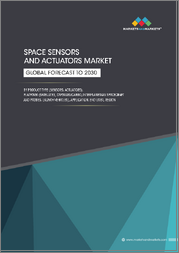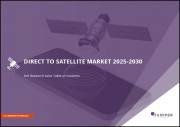
|
시장보고서
상품코드
1800750
아시아태평양의 대형 위성 추진 시스템 시장 : 서브시스템별, 지역별 - 분석과 예측(2025년-2040년)Asia-Pacific Large Satellite Propulsion System Market: Focus on Subsystem and Country - Analysis and Forecast, 2025-2040 |
||||||
아시아태평양의 대형 위성 추진 시스템 시장 규모는 2040년까지 3,370만 달러에 달할 것으로 예측됩니다.
아시아태평양의 대형 위성 추진 시스템 시장은 화학, 전기, 콜드 가스, 하이브리드 스러스터 등 다양한 우주 추진 기술을 포괄하고 있으며, 이들 모두 중량급 위성의 궤도 진입, 정지궤도 유지, 종말 기동 등에 필수적인 기술입니다. 이 지역에서는 고처리량 통신 위성, 첨단 지구관측 플랫폼, 상승하는 항법 별자리(모두 정확한 궤도 상승과 장시간의 스테이션 유지 능력을 필요로 함)의 이용이 증가하고 있으며, 이는 수요를 견인하고 있습니다. 고추력 전기 홀 효과 추진기, 친환경 화학 추진, 모듈식 하이브리드 스테이지는 아시아 우주 사업자들에게 확장 가능하고 저렴하며 지속 가능한 대안을 제공하기 위해 점점 더 많이 받아들여지고 있는 기술 혁신의 한 예입니다. 시장은 경쟁이 치열하며, 새로운 지역 제조업체도 있고, ISRO, JAXA, CNSA와 같은 아시아태평양 조직과 협력하는 국제 기업도 있습니다. 추진제의 효율성, 궤도상의 잔해물 감소, 임무의 유연성이 중요해지면서 조달 전술도 변화하고 있습니다. 이 때문에 재사용 가능한 추진 시스템 및 차세대 전기 추진에 대한 투자가 촉진되고 있습니다. 따라서 아시아태평양의 대형 위성 추진 시장은 기술 발전, 민간 부문의 참여 증가, 현대 우주 임무의 성능 요구 사항 증가로 인해 빠르게 변화하고 있습니다.
시장 소개
아시아태평양의 대형 위성 추진 시스템 시장의 강력한 성장에는 정부 우주 프로젝트 증가, 상업용 위성의 시도, 최첨단 우주 모빌리티 기술에 대한 투자 증가가 모두 기여하고 있습니다. 중량 위성의 궤도 진입, 정지궤도 진입, 자세 제어, 수명 말기 기동은 모두 화학, 전기, 냉가스, 하이브리드 기술을 포함한 추진 시스템에 의존하고 있습니다.
고처리량 통신 위성, 첨단 지구관측 플랫폼, 확장되는 항법 위성군의 배치가 모두 아시아태평양 수요를 가속화하는 데 기여하고 있습니다. 중국, 인도, 일본 등 국가들은 각국 우주기관의 지원 하에 야심찬 임무를 주요 기업으로 추진하고 있으며, 비상장 기업들은 지역 내 연구개발 및 제조 능력을 점점 더 강화하고 있습니다.
이 분야의 기술 동향에는 친환경 화학 엔진, 모듈식 하이브리드 설계, 홀 효과 추진기와 같은 고효율 전기 추진 장치의 사용이 포함되며, 이는 확장 가능하고 저렴한 솔루션을 제공합니다. 지역 생산자와 국제 항공우주 산업 전문가들과의 협업은 정보 공유를 촉진하고, 임무 적응성, 파편 감소, 추진제 효율성의 진보를 촉진하고 있습니다.
아시아태평양의 우주 산업이 더 큰 별자리와 더 긴 임무 수명으로 이동함에 따라, 고성능의 지속 가능한 추진 설계에 대한 수요가 크게 증가할 것으로 예측됩니다. 이 역동적인 시장은 신기술, 혁신적인 파트너십, 현대 우주 임무의 성능 요구가 증가함에 따라 현재도 빠르게 변화하고 있습니다.
시장 세분화
세분화 하위 시스템별
- 화학 추진기
- 추진제 탱크
- 펌프
- 연료 및 산화제 밸브
- 전기 추진기
- 추진제 탱크
- 펌프
- 콜드 가스 추진기
- 가스 저장 탱크
- 추진 챔버 및 노즐
- 펌프
- 하이브리드 스러스터
- 추진제 탱크
- 추진실 및 노즐
- 펌프
세분화 2: 지역별 세분화
- 아시아태평양
아시아태평양의 대형 위성 추진 시스템 시장 동향과 추진 요인 및 과제
동향
- 통신, 지구관측, 항법을 위한 첨단 페이로드를 탑재한 대형 위성 배치 확대
- 전기 추진 기술, 특히 홀 효과 추진기(HET)와 그리드 이온 엔진(GIE)의 통합이 증가하고 있습니다.
- 기존 항공우주기업과 JAXA, ISRO 등 아시아태평양 우주기관, 신생 비상장기업과의 협업
- 추진 시스템 및 AOCS 서브 시스템에서 디지털 모니터링 및 자율 제어의 채택 증가
- 원격지에서 저지연 광대역 연결을 제공하기 위한 대형 위성 별자리의 역할 확대
성장 촉진요인
- 국방 및 전략적 용도의 안전한 위성 통신 인프라를 강화하기 위한 정부의 강력한 이니셔티브
- 아시아태평양의 디지털 격차 해소를 위한 메가 위성 콘스텔레이션에 대한 수요가 증가하고 있습니다.
- 저연비, 저보수 추진 기술에 대한 연구개발 투자 증가
- 기후감시, 재난관리, 해양감시 등 우주기반 서비스 확대
과제
- 엄격한 규제와 대형 성좌별 궤도상의 우주 파편에 대한 우려
- 추진 서브시스템의 개발 및 통합에 드는 높은 비용과 복잡성 증가
- 저추력별 궤도변환 시간 연장 등 전기 추진의 한계
- 환경 및 안전 기준을 충족하기 위한 지속 가능하고 무해한 추진제의 필요성
제품/혁신 전략: 제품 유형은 독자들이 아시아태평양에서 사용할 수 있는 다양한 유형의 제품을 이해하는 데 도움이 됩니다. 또한, 추진 서브시스템을 기반으로 한 제품별 대형 위성 추진 시스템 시장에 대한 상세한 이해를 독자에게 제공합니다.
아시아태평양의 대형 위성 추진 시스템 시장에서는 사업 확장, 제휴, 협력, 합작 투자 등 시장에서 사업을 전개하는 주요 기업들에 의한 주요 개척을 볼 수 있습니다. 각 사가 선호하는 전략은 대형 위성 추진 시스템 시장에서의 지위를 강화하기 위한 시너지 활동입니다.
목차
주요 요약
제1장 지역
- 대형 위성 추진 시스템 시장(지역별)
- 아시아태평양
제2장 스러스터와 규제 분석
- 스러스터 분석(용도별)
- 하이브리드 스러스트
- 콜드 가스 스러스터
- 화학 스러스터(고온 가스 및 온가스)
- 전동 스러스터
- 애널리스트의 견해
- 규제 분석(국가별)
- 인도
- 중국
제3장 중요 고객 정보
제4장 성장 기회와 추천 사항
- 성장 기회
- 차세대 추진기 펌프를 위한 재료 과학의 발전
- AI 기반 예측 유지보수 및 효율 최적화의 통합
- 신흥 우주 및 상업 벤처에서의 시장 수요 확대
- 우주 응용을 위한 지속 가능하고 친환경적인 펌프 솔루션
- 대형 위성 궤도 이송 및 기동을 위한 태양광 전기 추진 시스템 개발
- 우주 기반 정보·감시·정찰(ISR) 솔루션에 대한 수요 증가
제5장 조사 방법
LSH 25.09.05This report can be delivered in 2 working days.
Introduction to Asia-Pacific Large Satellite Propulsion System Market
The Asia-Pacific large satellite propulsion system market is projected to reach $33.7 million by 2040. The large satellite propulsion system market in Asia-Pacific encompasses a broad spectrum of in-space thrust technologies, such as chemical, electric, cold-gas, and hybrid thrusters, all of which are essential for heavyweight satellite orbit insertion, station-keeping, and end-of-life maneuvers. The region's increasing use of high-throughput communication satellites, sophisticated Earth observation platforms, and rising navigation constellations-all of which need accurate orbit-raising and long-duration station-keeping capabilities-is driving demand. High-thrust electric Hall-effect thrusters, environmentally friendly chemical propulsion, and modular hybrid stages are examples of technological innovations that are being embraced more and more to provide space operators in Asia with scalable, affordable, and sustainable options. The market is competitive, with both new regional manufacturers and international firms working with APAC organizations like ISRO, JAXA, and CNSA. Procurement tactics are changing due to a greater emphasis on propellant efficiency, orbital debris mitigation, and mission flexibility. This is driving investments in reusable propulsion systems and next-generation electric propulsion. The market for large satellite propulsion in Asia-Pacific is therefore changing quickly due to advancements in technology, more involvement from the private sector, and the increasing performance requirements of contemporary space missions.
Market Introduction
The growing government space projects, commercial satellite endeavors, and increasing investments in cutting-edge in-space mobility technologies are all contributing to the strong growth of the Asia-Pacific (APAC) big satellite propulsion system market. Heavyweight satellite orbit insertion, station-keeping, attitude control, and end-of-life maneuvers all depend on propulsion systems, which include chemical, electric, cold-gas, and hybrid technologies.
The deployment of high-throughput communication satellites, sophisticated Earth observation platforms, and expanding navigation constellations are all contributing to the acceleration of demand in APAC. Under the auspices of their national space agencies, nations like China, India, and Japan are leading ambitious missions, while private companies are increasingly bolstering regional R&D and manufacturing capacities.
The region's technological trends include the use of environmentally friendly chemical engines, modular hybrid designs, and high-efficiency electric propulsion like Hall-effect thrusters, which provide scalable and affordable solutions. Collaborations between regional producers and international aerospace industry experts are promoting information sharing and propelling advancements in mission adaptability, debris reduction, and propellant efficiency.
The need for high-performance, sustainable propulsion designs is anticipated to increase significantly as the APAC space industry shifts toward larger constellations and longer mission lifespans. This dynamic market is still changing quickly due to new technology, innovative partnerships, and the increasing performance needs of contemporary space missions.
Market Segmentation
Segmentation: By Subsystem
- Chemical Thruster
- Propellant Tank
- Pump
- Fuel and Oxidizer Valve
- Electric Thruster
- Propellant Tank
- Pump
- Cold Gas Thruster
- Gas Storage Tank
- Propulsion Chamber/Nozzle
- Pump
- Hybrid Thruster
- Propellant Tank
- Propulsion Chamber/Nozzle
- Pump
Segmentation 2: by Region
- Asia-Pacific
APAC Large Satellite Propulsion System Market Trends, Drivers and Challenges
Trends
- Growing deployment of large satellites with advanced payloads for telecommunications, Earth observation, and navigation.
- Increasing integration of electric propulsion technologies, particularly Hall-effect thrusters (HET) and gridded-ion engines (GIE).
- Collaboration between established aerospace companies and APAC space agencies like JAXA, ISRO, and emerging private players.
- Rising adoption of digital monitoring and autonomous control in propulsion and AOCS subsystems.
- Expanding role of large satellite constellations to provide low-latency broadband connectivity in remote regions.
Drivers
- Strong government initiatives to strengthen secure satellite communication infrastructure for defense and strategic applications.
- Rising demand for mega-constellations to bridge digital divides across APAC.
- Growing R&D investments in fuel-efficient, low-maintenance propulsion technologies.
- Expansion of space-based services such as climate monitoring, disaster management, and maritime surveillance.
Challenges
- Stringent regulations and concerns over orbital space debris from large constellations.
- High costs and complexity of propulsion subsystem development and integration.
- Limitations of electric propulsion, such as low thrust leading to extended orbit transfer timelines.
- Need for sustainable, non-toxic propellants to meet environmental and safety standards.
How can this report add value to an organization?
Product/Innovation Strategy: The product segment helps the reader understand the different types of products available in the Asia-Pacific region. Moreover, the study provides the reader with a detailed understanding of the large satellite propulsion system market by products based on propulsion subsystems.
Growth/Marketing Strategy: The APAC large satellite propulsion system market has seen major development by key players operating in the market, such as business expansion, partnership, collaboration, and joint venture. The favored strategy for the companies has been synergistic activities to strengthen their position in the large satellite propulsion system market.
Methodology: The research methodology design adopted for this specific study includes a mix of data collected from primary and secondary data sources. Both primary resources (key players, market leaders, and in-house experts) and secondary research (a host of paid and unpaid databases), along with analytical tools, have been employed to build the predictive and forecast models.
Table of Contents
Executive Summary
Market/Product Definition
1 Regions
- 1.1 Large Satellite Propulsion System Market (by Region)
- 1.1.1 Asia-Pacific
- 1.1.1.1 Asia-Pacific Large Satellite Propulsion System Market (by Subsystem)
- 1.1.1.2 Asia-Pacific (by Country)
- 1.1.1.2.1 China
- 1.1.1.2.1.1 China Large Satellite Propulsion System Market (by Subsystem)
- 1.1.1.2.2 India
- 1.1.1.2.2.1 India Large Satellite Propulsion System Market (by Subsystem)
- 1.1.1.2.3 Japan
- 1.1.1.2.3.1 Japan Large Satellite Propulsion System Market (by Subsystem)
- 1.1.1.2.4 Rest-of-Asia-Pacific
- 1.1.1.2.4.1 Rest-of-Asia-Pacific Large Satellite Propulsion System Market (by Subsystem)
- 1.1.1.2.1 China
- 1.1.1 Asia-Pacific
2 Thruster and Regulatory Analysis
- 2.1 Analysis of Thrusters (by Application)
- 2.1.1 Hybrid Thruster
- 2.1.1.1 Maneuvering and Attitude Control
- 2.1.1.2 End-of-Life Deorbiting
- 2.1.1.3 Orbit Transfer
- 2.1.1.4 Docking
- 2.1.1.5 Station Keeping (Impulse Bits)
- 2.1.1.6 In-Orbit Transportation
- 2.1.2 Cold Gas Thruster
- 2.1.2.1 Maneuvering and Attitude Control of Satellites
- 2.1.2.2 Astronaut Maneuvering (Spacewalk)
- 2.1.2.3 End-of-Life Deorbiting
- 2.1.2.4 Reaction Wheel Unloading
- 2.1.2.5 Orbit Transfer
- 2.1.2.6 Launch Vehicle Roll Control
- 2.1.3 Chemical Thruster (Hot and Warm Gas)
- 2.1.3.1 Maneuvering and Attitude Control
- 2.1.3.2 Landing Control for Interplanetary Landers
- 2.1.3.3 Launch Vehicle Roll Control
- 2.1.4 Electric Thruster
- 2.1.4.1 Maneuvering and Orientation Control
- 2.1.4.2 Primary Propulsion for Deep Space Missions
- 2.1.4.3 Attitude Control for Microsatellites
- 2.1.4.4 Station Keeping (Impulse Bits)
- 2.1.5 Analyst Perspective
- 2.1.1 Hybrid Thruster
- 2.2 Regulatory Analysis (by Country)
- 2.2.1 India
- 2.2.1.1 Indian Space Policy 2023
- 2.2.2 China
- 2.2.2.1 China Space Standard System
- 2.2.1 India
3 Key Customer Information
- 3.1 Key Customer Information
4 Growth Opportunities and Recommendations
- 4.1 Growth Opportunities
- 4.1.1 Advancements in Material Science for Next-Generation Thruster Pumps
- 4.1.2 Integration of AI-Driven Predictive Maintenance and Efficiency Optimization
- 4.1.3 Expanding Market Demand in Emerging Space and Commercial Ventures
- 4.1.4 Sustainable and Eco-Friendly Pump Solutions for Space Applications
- 4.1.5 Development of Solar Electric Propulsion System for Large Satellite Orbital Transfer and Maneuver
- 4.1.6 Growing Demand for Space-Based Intelligence, Surveillance, and Reconnaissance (ISR) Solutions
5 Research Methodology
- 5.1 Data Sources
- 5.1.1 Primary Data Sources
- 5.1.2 Secondary Data Sources
- 5.2 Data Triangulation



















